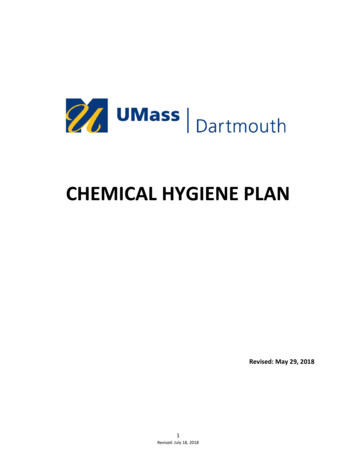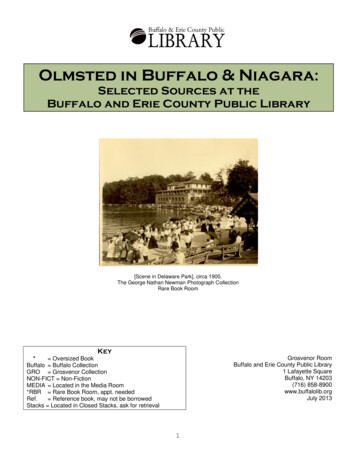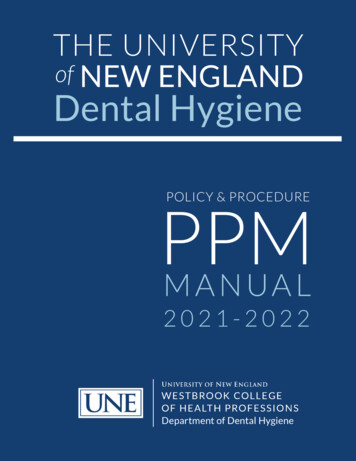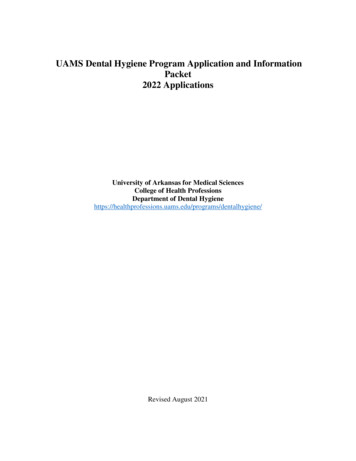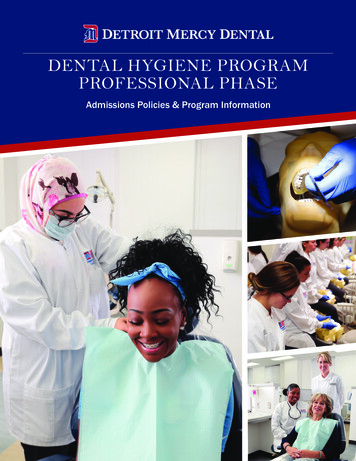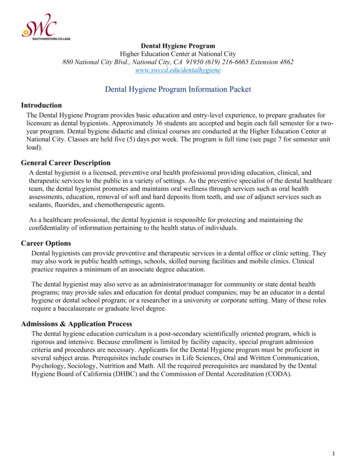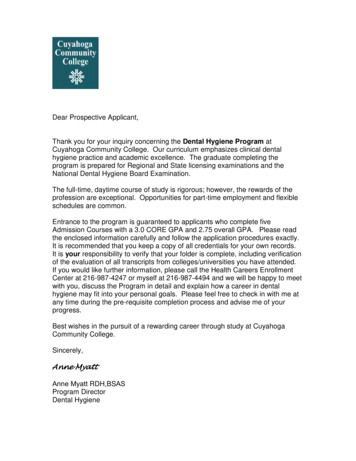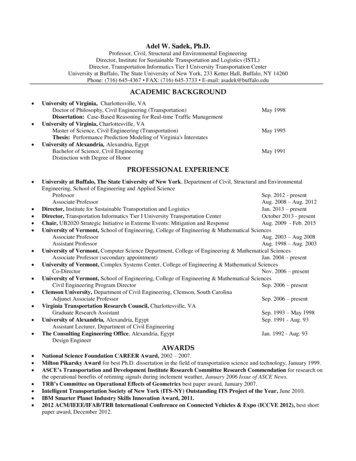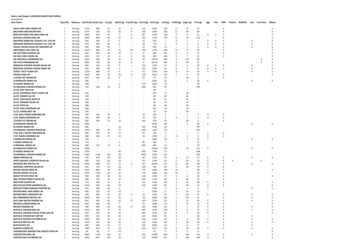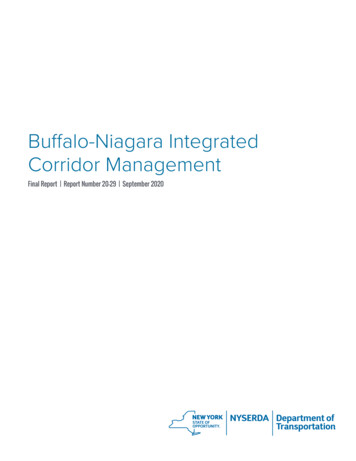
Transcription
Chemical Hygiene Plan for the University at BuffaloChemical Hygiene Planfor theUniversity at BuffaloIssued 9/25/2013Revised 8/29/2019Environment, Health & Safety ServicesUniversity at Buffalo220 Winspear Ave.South Campus716-829-3301buffalo.edu/ehs
Chemical Hygiene Plan for the University at BuffaloWhat’s New in the 2019 UpdatePageType of ChangeHow to Proceed in aCampus EmergencyUpdated Contact Information for Emergencies3-1Added information on mandatory laboratory safety training.5-1, 5-2Added a statement on how to request a lab door sign via the EH&Swebsite. Changed the upper limit for fume hood air velocity from 100feet per minute (fpm) to 120 fpm5-4Updated Contact Information in the In Case of Fire table10-1, 10-2Updated Section on Labeling Secondary Containers; added agraphic of a typical GHS label13-1Clarified the wording on the introductory paragraph13-2Updated Chemical Inventory Requirements13-3Added a Risk Assessment Tool topic14-1Updated wording to reflect current practices; In the last bullet on thepage, changed required training to mandatory training15-1Updated Contact Information for EmergenciesA-15Removed the outdated Select Agents and Toxins table in AppendixG. Readers are now directed to the government website for the mostup-to-date information.AcknowledgementsUB Environment, Health & Safety wishes to acknowledge the following institutionswhose websites provided information and resources that were referencedcreating this plan: Cornell UniversityUniversity of PennsylvaniaStanford UniversityPurdue UniversityHarvard UniversityArizona State UniversityUCLA
Chemical Hygiene Plan for the University at BuffaloHow to Proceed in a Campus EmergencyContacts for Police, Fire, Suspicious Behavior or MedicalEmergencies:For North & South CampusesCall: 645-2222(UB Police)For Downtown Campus Including:CBLSCall: 645-2222CTRC(UB Police)Jacobs School, 955 Main StreetFor All Other Off Campus UBLocationsCall 911When making an emergency call: Give your name, location, and phone numberDescribe what happenedDo not hang up until asked to do soNon-emergency hazardous material concerns: 829-3301 (EH&S)Environment, Health & Safety can assist with: Information on biological, chemical, fire, radiation, laser,occupational, laboratory and general campus safety Contacting Chemical Hygiene Officer, Chemical Hygiene Plan, OSHALaboratory Standard Safety Training Programs Hazardous Waste DisposalOther Resources:Poison Control Center of WNY:878-7654
Chemical Hygiene Plan for the University at BuffaloBuilding Utilities Emergencies:645-2025
Chemical Hygiene Plan for the University at BuffaloTable of Contents1.Introduction . 1-1Purpose . 1-1Scope . 1-12.Positions and Responsibilities . 2-13.Chemical Hygiene Plan General Requirements .3-1Training . 3-1Availability of Plan and Frequency of Review .3-1Lab Inspections . 3-14.Hazardous Chemical Descriptions .4-15.Controls in Place to Reduce Exposures .5-1Administrative Controls . 5-1Engineering Controls . 5-16.Personal Protective Equipment (PPE).6-1Types of PPE . 6-27.General Lab Safety Rules . 7-1Personal Hygiene . 7-1Housekeeping . 7-2Prior Approval . 7-2Handling of Chemicals. 7-3Transporting Chemicals. 7-48.Special Provisions for Working with Particularly HazardousMaterials . 8-1Definition of Particularly Hazardous Materials .8-1Non-Chemical Particularly Hazardous Materials .8-2Responsibilities . 8-3Hazard Control for Particularly Hazardous Materials .8-3Substitution & Other Procedural Modifications .8-4Standard Operating Procedures (SOPs) .8-4Designated Area . 8-5Access Control . 8-5
Chemical Hygiene Plan for the University at BuffaloContainment . 8-6Decontamination . 8-6Waste Disposal . 8-6Prior Approval for Restricted Use & Extremely ToxicChemicals. 8-69.Storage of Chemicals . 9-1Storage of Reagent Chemicals . 9-1Flammable Liquids . 9-2Pyrophoric and Water-Reactive Substances . 9-3Oxidizers . 9-3Peroxide Forming Chemicals . 9-3Corrosives . 9-4Controlled Substances . 9-410. Labeling of Chemicals . 10-1Labeling Secondary Containers . 10-1Chemical Substances Developed or Synthesized byLaboratories . 10-2Special Labeling for Highly Toxic Materials. 10-211. Handling of Compressed Gases . 11-112. Cryogenic Safety . 12-1Special Precautions for Working with Cryogens: . 12-113. Hazard Communication and Identification. 13-1Safety Data Sheets (SDS) . 13-1Chemical Substances Developed by Laboratories . 13-1Chemical Inventory Requirements . 13-2Lab Specific Standard Operating Procedures (SOPs) . 13-2Risk Assessment Tool . 13-314. Managing Hazardous Wastes . 14-115. Chemical Spills . 15-1Spill Reporting . 15-1Mercury Use and Spill Cleanup . 15-2Small Mercury Spill . 15-316. Medical Surveillance, Monitoring and Consultation. 16-1Definitions . 16-1Responsibilities . 16-2Medical Exam Criteria and Frequency . 16-3
Chemical Hygiene Plan for the University at BuffaloExam Information and Results .16-3Recordkeeping . 16-4Appendices . 1Appendix A . 2Definitions. 2Appendix B . 9Principal Investigator General Responsibilities Related toEH&S Checklist . 9Appendix C . 10Laboratory Specific Standard Operating Procedures . 10Appendix D. 11Laboratory Door Signage Program . 11Appendix E . 13Compressed Gas Cylinder Safety . 13Appendix F. 14Carcinogens and Highly Hazardous Chemicals . 14Appendix G . 16Select Agents and Toxins List . 16Appendix H . 17Management of Peroxide Forming Chemicals. 17Appendix I . 20Chemical Compatibility Chart . 20Appendix J. 21Acute Toxicity Hazard Designations . 21
Chemical Hygiene Plan for the University at Buffalo1. IntroductionPurposeEnvironment, Health and Safety Services (EH&S) at the University atBuffalo (UB) strives to provide a workplace free of recognizedhazards. The purpose of this Chemical Hygiene Plan (CHP) is toestablish a written program that protects laboratory personnel fromthe potential hazards associated with the use, storage, and disposalof hazardous chemicals in a laboratory work area. This documentmeets the requirements of the Occupational Safety HealthAdministration (OSHA) regulations; Standards for Laboratories listedin 29 CFR 1910.1450 and Standards for Personal ProtectiveEquipment (PPE), listed in 1910.132. Compliance with the guidelinesset forth by the CHP should protect laboratory personnel from mostpotential chemical hazards.Additional information can be obtained by referring to thepublications “Prudent Practices in the Laboratory: Handling andManagement of Chemical Hazards” published by the NationalResearch Council and the American Chemical Society’s “Safety inAcademic Chemistry Laboratories.” Both of these publications areexcellent resources for guidance and can help strengthen andsolidify a culture of safety in academic laboratories. They areavailable through a number of online sources.ScopeUB’s CHP applies to all University at Buffalo laboratory personnel andcampus laboratories as defined in this CHP. It does not apply tohazardous chemicals that are in use in an area not defined as alaboratory; nor does the CHP cover work with radioactive materialsor biological agents. Those areas have specific requirements thatare addressed in separate documents. Contact the EH&S office at829-3301 for further information.Revised 8-29-20191-1
Chemical Hygiene Plan for the University at Buffalo2. Positions and ResponsibilitiesChemical Hygiene Officer (CHO): The CHO is responsible forproviding technical guidance in the development andimplementation of the provisions of this chemical hygiene plan. TheCHO is a staff member of EH&S.University at Buffalo Environment, Health and Safety Services (EH&S):EH&S is responsible for institutional oversight of compliance with theOSHA Laboratory Standard as well as the overall campus-wideimplementation of this plan. In addition, EH&S will maintain andupdate the CHP as needed and provide training on its requirements.Deans and Department Heads/Chairs: The various University Deansas well as individual department heads and chairs are responsiblefor establishing compliance with the CHP and implementation of theplan within each department. To foster this atmosphere ofcompliance, a chair may wish to designate a safety officer withinthe department to ensure compliance. This safety officer must befamiliar with the CHP.Principal Investigator/Laboratory Supervisor/Laboratory Manager:Each Principal Investigator (PI) or lab supervisor must implement andfollow this CHP in their respective areas of responsibility. They are alsoresponsible for ensuring individuals under their control obtain thenecessary training associated with the CHP. They must developspecific standard operating procedures (SOPs) and polices to makecertain the employees are made aware of health hazardsassociated with chemicals located within the laboratory. These SOPsor policies must be placed in and become an addendum to thelab’s CHP. The PI or lab supervisor must provide training on all labspecific SOPs. This training must be documented. Guidance onwhen a SOP may be required can be found in Appendix C.PIs are responsible for the following: Be familiar with the contents of this CHPOversee the selection and use of personal protectiveequipment (PPE) in the lab. A laboratory policy must beestablished which outlines when PPE is to be used. EH&S isavailable for assistance in the selection of proper PPEMust provide either a library of Safety Data Sheets (SDS) intheir laboratory or have the information readily available viaonline computer sources per OSHA regulations. Electronicmedia such as a CD or DVD disk is also acceptableMust familiarize themselves with the necessary steps to betaken in the event of an emergency situationLaboratory worker: Laboratory workers include personnel whoconduct their work in a laboratory and are at risk of possibleexposure to hazardous chemicals on a regular or periodic basis.These personnel include laboratory technicians, instructors,researchers, visiting researchers, administrative assistants, graduateRevised 8-29-20192-1
Chemical Hygiene Plan for the University at Buffaloassistants, student aides, student employees, and part-time andtemporary employees and volunteer appointments. All thoseworking in a lab environment must: Be familiar with the hazards associated with working in alaboratory and the proper procedures outlined in this CHPMust make themselves available for training as directed bytheir supervisorWear proper PPE for the task being performed anddemonstrate good general lab safety habitsInform their supervisor of any unsafe practices, conditions, orgeneral hazards present in their work areaFamiliarize themselves with the steps to be taken in the eventof an emergency situationIf you as a lab worker feel the experiment or research you areconducting is not being performed in a safe manner or may causean injury to you or someone else, it is your responsibility to bring it toyour PI or supervisor’s attention and if necessary EH&S.Contractors, Vendors, and Visitors: Each laboratory group isresponsible for ensuring contractors, vendors, custodial workers, andvisitors are made aware of the hazards associated with the areathey are visiting. Any necessary personal protective equipment (PPE)must be worn while in the laboratory space. PPE is to be provided toall visitors by the lab or by contractor agreement. EH&S may becontacted if you have questions about what PPE should be used.Revised 8-29-20192-2
Chemical Hygiene Plan for the University at Buffalo3. Chemical Hygiene Plan GeneralRequirementsTrainingThe Principal Investigators or lab supervisors shall provide alllaboratory workers with the necessary information concerning thehazards of chemicals in his/her lab. Training shall consist of: Contents of this Chemical Hygiene PlanPotential hazards of common chemicals in the labHow to protect yourself from these hazards, covering topicssuch as safe work practices, proper PPE, emergencyprocedures, etc.How to locate, read and understand a safety data sheet(SDS)Additionally, each PI will ensure said laboratory worker attendsmandatory Laboratory Safety Training sessions provided by EH&S onlaboratory “right to know” and hazardous waste managementtraining. Information on dates, times and the location of LaboratorySafety Training can be found on the EH&S website.Availability of Plan and Frequency of ReviewThis CHP will be made available to every laboratory space locatedat the University at Buffalo where chemicals are in use.The plan shall be reviewed yearly and updated if necessary.Lab InspectionsLab inspections are an integral component of a thorough laboratorysafety program. Inspections identify and address potential healthand safety deficiencies and also are conducted to fulfill regulatorycompliance requirements. Each laboratory and/or laboratory groupis required to participate in the University’s inspection program.Inspections are conducted by EH&S on a regular basis, usually oncea year depending on the scope and nature of the hazardsassociated with that specific lab. Areas of focus may include, butare not limited to: housekeeping, hazardous waste management,reagent and hazardous materials storage, electrical safety, use ofPPE, compressed gas safety, etc.Revised 8-29-20193-1
Chemical Hygiene Plan for the University at Buffalo4. Hazardous Chemical DescriptionsAllergens and Sensitizers: This group of chemicals causes exposedpersons to develop an allergic reaction in normal tissues afterrepeated exposures. Exposures to even very small amounts of thesame substance can trigger an allergic response.Persons who have developed an allergy can manifest the allergicresponse as a skin rash, eye irritation, allergic asthma, or, in severeallergic reactions, anaphylactic shock that can result in death if nottreated quickly enough.Corrosives: Corrosives are chemicals that can attack andchemically destroy exposed body tissue. Damage is possible fromthe point it comes in contact with skin. Exposure to corrosives cancause damage to the eyes, skin and respiratory tract. A corrosivecan be in the form of a liquid, solid or a gas.Extremely Toxic Chemicals: Toxic chemicals are chemicals that canproduce injury or death when inhaled, ingested, or absorbedthrough the skin. Damage may result from acute or chronicexposures and involve local tissue or internal organs. The extent ofthe injury depends on the dose administered, duration of theexposure, physical state, solubility, and interaction with otherchemicals.Flammable Liquids: Flammable and combustible liquids areclassified according to their flash points with flammable liquidshaving a flashpoint of 100 F and combustible liquids a flashpointbetween 100-200 F. Both are considered fire hazards; all flames andsparks should be kept away.Flammable Solid: A solid that is capable of causing a fire throughfriction, absorption of water, spontaneous chemical change, heatretained from a manufacturing process, or that can be ignited easilyand when ignited, burns so vigorously or persistently as to create aserious fire hazard.Irritants: Irritants are chemicals that can cause inflammation of bodytissue by chemical action. There are a wide variety of inorganic andorganic chemicals that are considered irritants; skin contact shouldbe avoided. In some cases, the damage caused by exposure toirritants can be reversible.Nanomaterials: A nanomaterial or nanoparticle (or nanopowder ornanocluster or nanocrystal) is a microscopic particle with at leastone dimension less than 100 nm. Engineered nanoparticles areintentionally produced and designed with very specific properties inrelation to their size, shape and surface properties. Eachnanomaterial has its own unique toxic properties.Pyrophoric Chemicals: Pyrophoric substances are extremely reactiveand can ignite spontaneously when contacted with air even in theabsence of heat or fire. Extreme caution must be taken whenRevised 8-29-20194-1
Chemical Hygiene Plan for the University at Buffaloworking with them. Pyrophoric chemicals can be handled andstored safely so long as exposure to atmospheric oxygen andmoisture is avoided.Reactive Chemicals: Reactive and other unstable chemicalcompounds are materials which under certain conditions have thepotential to vigorously or violently polymerize, decompose, orotherwise become self-reactive. They may react under conditions ofshock, pressure, or temperature, or may adversely react with otherincompatible materials.Water Reactive: Water reactive materials can react violently orvigorously in contact with water, wet surfaces, or even the moisturein the air. These chemicals may react to give off a flammable gas(such as hydrogen) or a toxic gas, (such as phosgene) orspontaneously burn or explode.Revised 8-29-20194-2
Chemical Hygiene Plan for the University at Buffalo5. Controls in Place to ReduceExposuresAdministrative ControlsAdministrative controls consist of various policies and procedures putinto place with the purpose of limiting chemical exposures. Theymay include safety policies, rules, rotating work schedules, doorpostings and training. These controls help reduce the duration,frequency, and severity of an exposure to a hazardous chemical. PIscan assist by designing experimental procedures that minimize theprobability and degree of exposure.Lab Door Signs: Laminated lab door signs are required for alllaboratories and areas that contain hazardous materials. Thesignage complies with applicable regulations and provides aconsistent look for all campus locations where hazardous materialsare in use. Information on the sign can inform staff and emergencyresponders about the types of hazards that are in the lab and if anyprecautions are required. The sign also provides contact informationof who to notify in case of an emergency in the room or area.Additionally, information concerning the correct personal protectiveequipment can be accessed prior to entering the lab. Refer toAppendix D for more information on the laboratory door signageprogram.The hazard sign can be obtained by completing an on-line formavailable on the EH&S website. If information contained on the labsign requires updating (such as adding or deleting hazardousmaterials, change of emergency contacts, etc.) it is the responsibilityof the laboratory personnel to contact EH&S so an updated sign canbe created.Engineering ControlsEngineering controls are those that are put into place to reduce thepotential exposure to hazardous materials. Controls may includelaboratory chemical fume hoods, glove boxes, biosafety cabinets,etc. This section describes some of the more common engineeredcontrols that are in place at UB.Laboratory Chemical Hoods (Fume Hoods): Laboratory chemicalfume hoods must be used whenever a hazardous chemical ormaterial is in use. The hood sash maximum height must be set at orbelow the certification sticker provided by EH&S. A sash placed atthis level provides the minimum protection requirements. Laboratory chemical fume hoods should provide 80-120 feetper minute (fpm) of air velocity at the sash height indicatedby the EH&S inspection label placed on the unit.Keep the sash lowered at all times except to adjustapparatus that is inside the hood.Revised 8-29-20195-1Example of a UBLaboratory Door Sign
Chemical Hygiene Plan for the University at Buffalo Figure 1 EHS Fume Hood Sticker Hood fan must be kept on at all times while chemicals are inuse or work is being performed inside.Practice good housekeeping: hoods should never be usedas storage areas for chemicals, apparatus, or other materials.The rear of the hood (baffle area) should be open and clearof obstruction.The face velocity of the fume hood will be checked annuallyby EH&S. The inspection date as well as the sash heightrequired to deliver the required 80-120 fpm shall be placedon the front on the hood. If your hood inspection stickerindicates that it has not been inspected within the last 12months, contact the EH&S office for an evaluation andinspection.Fume hoods found to not provide minimum protection will betagged out of service and a warning label will be attachedto the window sash. Under no circumstances is a hood to beused if EH&S or UB Facilities tags it out of service.Modifications to any existing chemical fume hood orventilation system require prior approval by EH&S or UBFacilities.If repairs are required, contact Facilities Customer Service at645-2025.For more information on laboratory chemical fume hoodsconsult the American National Standard for LaboratoryVentilation (ANSI/AIHA Z9.5-2003).Glove Boxes: A glove box can operate under either negative orpositive pressure depending on the specific application. If thematerial is highly toxic, use of an exhaust system emptying into anadjacent laboratory chemical hood may be required. Regularinspection and maintenance of all components is essential to makecertain the glove box is in working order and not leaking. The gloveespecially should be checked for cracks, splits, cuts, etc. andreplaced if necessary.Biosafety Cabinets: Biosafety cabinets, tissue culture hoods, etc.,containing HEPA filters are in use in certain areas of the University.Although they will protect the laboratory worker and the surroundingenvironment from pathogens, they afford no or little protection fromchemical vapors, fumes or mists. These units must be certified yearlyand when moved to another location. EH&S does not provide thisservice. Users must contact an outside vendor and makearrangements for annual certification. A list of vendors is availablethrough the EH&S office. Since this Chemical Hygiene Plan coverschemical hazards only, please contact the EH&S office if you requireadditional information on the use of biosafety cabinets.HEPA filters may be used for toxic solids and particulates. However,be aware that air from these devices may be exhausted back intothe laboratory atmosphere.Note: Laminar flow hoods, PCR ductless hoods, and vertical flowclean benches are designed to protect the product/sample andnot the individual. These devices are not considered biosafetyRevised 8-29-20195-2
Chemical Hygiene Plan for the University at Buffalocabinets and are not to be used as a substitute for a biosafetycabinet or a replacement for a fume hood. They can be used forcertain clean activities, such as dust-free assembly of sterileequipment or electronic devices. However, they must never be usedwhen handling cell culture materials, potentially infectious materialsor any other potentially hazardous materials.Eyewash and Safety Showers: In laboratories where hazardouschemicals are in use, particularly corrosives and flammables, aneyewash station and safety shower must be in close proximity to thework area. Familiarize all laboratory workers with the location of theeyewash station and safety shower in your work area. Plumbed eyewash stations must be activated by laboratorypersonnel on a weekly basis to ensure the valve functionsproperly. If it does not, contact University Facilities CustomerService at 645-2025 for maintenance. For stations that arelocated in public hallways, the individual departments willassume responsibility for the weekly testing. For stations thatare unplumbed, place a bucket or pail under the drainpipeto capture test water.Access to eyewash/showers must not be blocked. There mustbe a clear path to the eyewash/shower unit with noobstructions that may impede access. Nozzle covers must bekept on the eyewash nozzles at all times. This is to preventdust from covering the nozzle and possible presence ofbacteria that may form on the nozzle after a period of nonuse.EH&S inspects all eyewash stations on a yearly basis perAmerican National Standards Institute standards (ANSIZ358.1-2004). All units should have a tag attached that liststhe inspections dates. If your unit does not have a tag,contact the EH&S office so they may add it to the inspectionlist.In areas where plumbed installation is not possible, aportable wall mounted eyewash station is acceptable. Thesaline solution contained in them must be monitored toensure it has not passed its expiration date; it must bereplaced when this occurs.Flammable Cabinets: Flammable liquid storage cabinets areintended for the storage of flammable and combustible liquids andare an important fire prevention and control device within manylaboratories. See Chapter 9, “Storage of Chemicals” for additionalinformation on the proper use and requirements of flammable liquidcabinets.Fire Extinguishers: In all laboratories where combustible andflammable chemicals are in use, an appropriate fire extinguishermust be available. All extinguishers must be wall mounted or inRevised 8-29-20195-3
Chemical Hygiene Plan for the University at Buffalolabeled cabinets. Access to them must be unblocked. Lab workersmust familiarize themselves with their location, use and classification.Laboratory workers are NOT required to extinguish a fire but may doso if: It’s a small fire, typically the size of a trash can or smallerYou have been trained in the use of an extinguisherThe area around the fire is safe, e.g. limited quantities offlam
Added information on mandatory laboratory safety training. 5-1, 5-2 ; Added a statement on how to request a lab door sign via the EH&S . laser, occupational, laboratory and general campus safety Contacting Chemical Hygiene Officer, Chemical Hygiene Plan, OSHA . a chair may wish to designate a safety officer within the department to .
